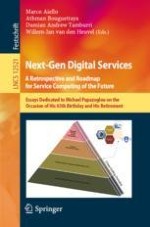2021 | Buch
Next-Gen Digital Services. A Retrospective and Roadmap for Service Computing of the Future
Essays Dedicated to Michael Papazoglou on the Occasion of His 65th Birthday and His Retirement
herausgegeben von: Prof. Dr. Marco Aiello, Athman Bouguettaya, Damian Andrew Tamburri, Prof. Willem-Jan van den Heuvel
Verlag: Springer International Publishing
Buchreihe : Lecture Notes in Computer Science
